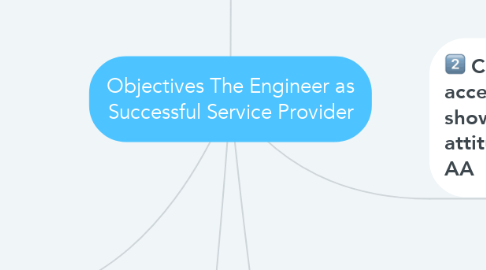
1. Work safely to protect yourself and the customer's personnel and workplace
1.1. Perceive and define the safety risks in your work environment
1.1.1. Execute an On Site Risk Assessment
1.1.2. Interpret local safety instructions correctly
1.1.3. Classify risks in electrical, mechanical...
1.1.4. Explain why the safety risks differ with the type, dimensions etc of the door you are servicing
1.2. Take the correct safety measures needed for yourself and your close environment, execute them correctly and at the right moment in the work process
1.2.1. Apply the Safety Guidelines in securing your health and safety and to prevent damage to your tools and the customer's property
1.2.1.1. Be qualified with VCA certificate
1.2.1.2. Match risks with the relevant safety measure
1.2.1.2.1. Decide on generic and specific safety measures for your work area
1.2.1.2.2. Decide on safety measures for your personal safety
1.2.1.3. Apply safety measures correctly
1.2.1.3.1. Wear the Personal Protection correctly when needed
1.2.1.3.2. Apply safety measures for your work area
1.2.1.3.3. Keep your work area clean and tidy
1.2.2. Decide under which conditions it is unsafe to continue your job
1.2.2.1. Convince the customer to support you in taking the necessary safaty measures
2. Use the resources available to find specific job information and correct solutions for product service
2.1. Match the type of information in the resources you can find on your tablet to the steps in your work process
2.1.1. Find resources on your TABLET
2.1.2. Describe the types of information in the apps on your tablet
2.1.2.1. Key Point Knowledge Center
2.1.2.2. FMP 360
2.1.2.3. MFQ
2.2. Identify relevant information in the LOGBOOK
2.3. Relate a work order to the protocol
2.4. Question door users to collect information indicating (future) malfunction
2.5. Use the MANUAL for the specific product group
2.5.1. Explain the code for identifying a particular door
2.5.2. Find the doors in the work order in the manual
2.5.3. Give the most common methods for finding answers in the manual
2.6. Discuss your work approach correctly and friendly with your colleague, planner and team leader
3. Convince the customer to accept your technical advice by showing a professional attitude/ as an ambassador for AA
3.1. Keep yourself and your van neat and tidy to communicate respectfully
3.2. Introduce yourself and the purpose of your visit to the customer
3.2.1. Explain the objectives and desired result of PM
3.2.1.1. Restate the concept of prevention in your own words
3.2.1.2. Restate the concept of risk in your own words
3.2.1.3. Give an example of the relationship between risk and preventive maintenance for your own vehicle
3.2.2. Explain the objectives and desired result of responding to a service call
3.3. Motivate the importance of periodical preventive maintenance and timely replacements for the customer and for the service organization (Change Before It Breaks)
3.3.1. Explain the relationship between technical failure and safety risks
3.3.1.1. Give examples of technical consequences of postponing or skipping PM turns
3.3.1.1.1. Explain the relationship between ageing, wear and tear of parts, intensity of use and lifetime of parts
3.3.1.2. Give examples of safety consequences of postponing/skipping PM
3.3.2. Give examples of consequences for the client's business objectives of replacing or upgrading parts
3.3.2.1. Use the cost argument
3.3.2.2. Use the time/efficiency argument
3.3.2.3. Use the safety argument
3.3.3. Motivate the importance of good and timely PM for the service organization
3.3.3.1. Explain the chain of responsibility for damage or injury from client to service organization to, eventually the service engineer
3.4. Leave the workplace clean and tidy
3.5. Accept feedback from the customer
3.6. Transfer relevant information to the customer
3.6.1. Complete the checklist
3.6.2. Write a quote for extra work
3.7. Transfer information about the work and the customer to the service organisation
4. Work methodically to achieve the best results
4.1. Regulate the work process by applying the PROTOCOL
4.1.1. Recognize the steps in the protocol
4.1.2. List the steps in the protocol
4.1.3. Explain the logic in the order of the steps in the protocol (First Time Right)
4.1.4. Illustrate with examples why each product group has his own protocol
4.1.5. Discuss the importance of working according to a protocol
4.1.6. Illustrate where you can deviate from the protocol without consequences for the quality of inspection
4.2. Explain the logic of the steps in the SOLVE approeach for response on an service call
4.2.1. Match actions in the problem solving process to steps in the SOLVE approach
4.3. Avoid the pitfalls of problem solving
4.3.1. Rephrase the pitfalls of technical problem solving: "Jumping to conclusions" and "Sinking in solutions"
4.3.1.1. Illustrate the risks of Jumping/Sinking with examples
5. Judge the quality of an "Engineer as Service Provider"
5.1. Match your behaviour to the insight in the customers needs
5.1.1. Categorize customers in the factors that determine their satisfaction
5.1.2. Demonstrate service oriented behaviour
5.1.2.1. Define the concept of "service provider"
5.1.2.2. List criteria for "good service"

